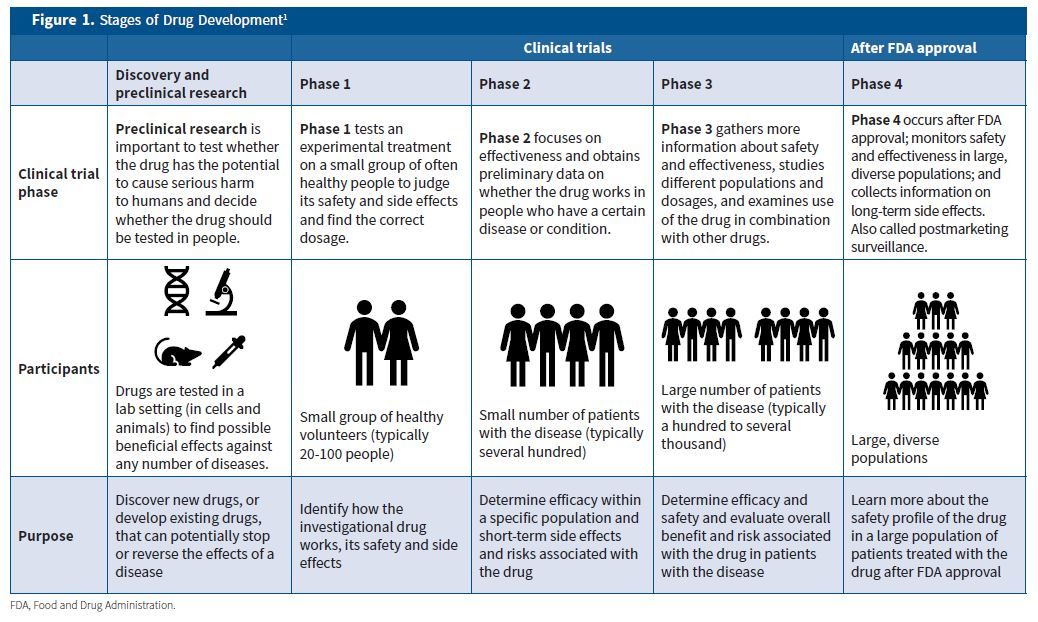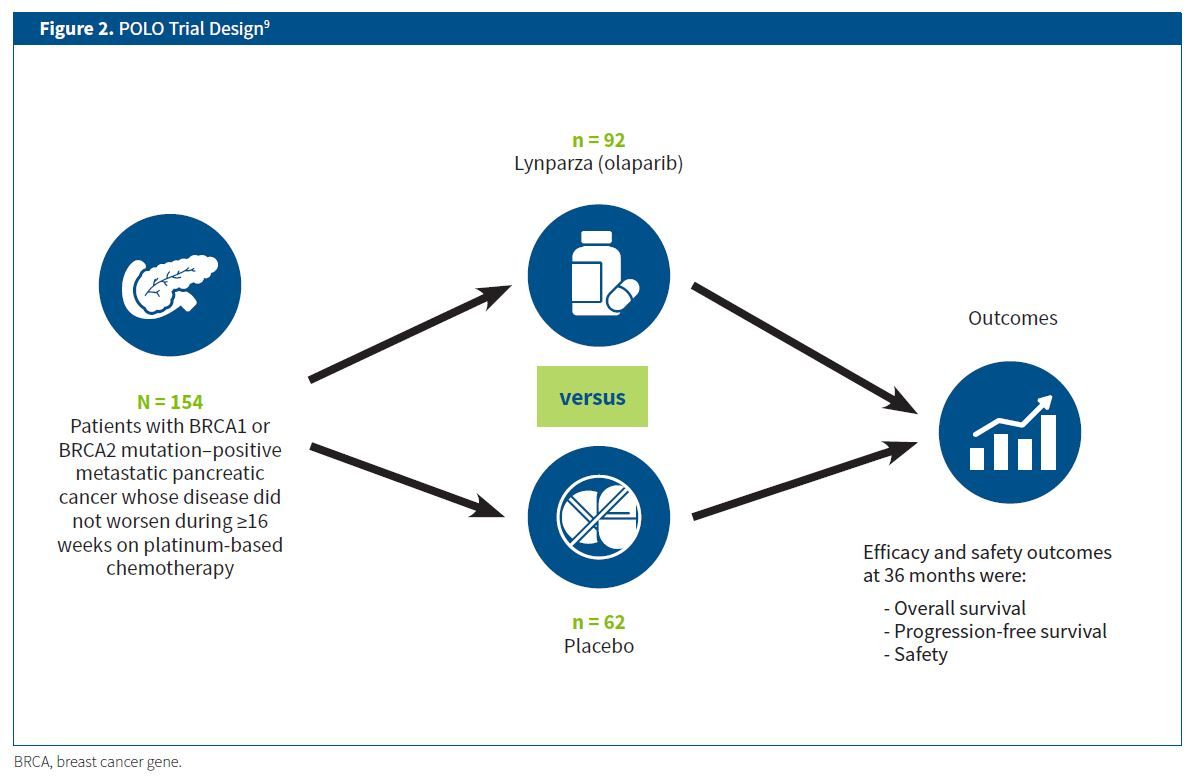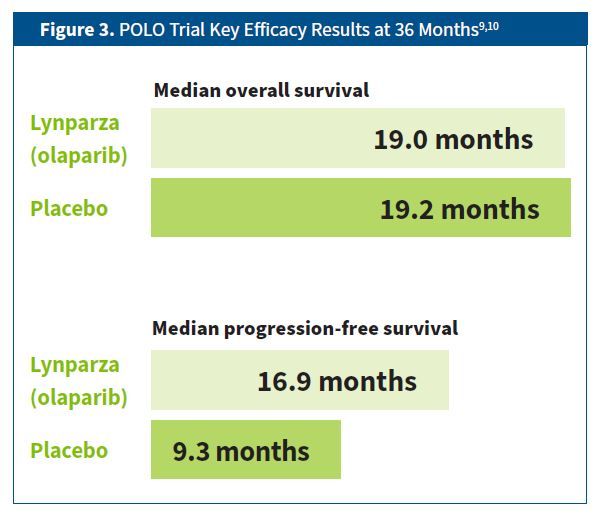Article
ASCO GI 2021: Results From the Phase 3 POLO Trial
The Educated Patient®: Research Updates provides current clinical updates for different disease states. The following information is for educational purposes and is not medical advice.
FOR YOUR REFERENCE: What Are Clinical Trials?
Clinical trials determine whether a drug works in humans and if it is safe and effective. To find out whether a drug can be approved for use, the Food and Drug Administration (FDA) requires four phases of a clinical trial. The number of participants increases in each phase, starting from 20 to 80 people for a phase 1 trial to up to 3,000 for a phase 3 trial (Figure 1).1
- Phase 1: tests an experimental treatment on a small group of often healthy people to judge its safety and side effects and find the correct dosage.
- Phase 2: focuses on effectiveness and obtains preliminary data on whether the drug works in people who have a certain disease or condition.
- Phase 3: gathers more information about safety and effectiveness, studies different populations and dosages, and examines use of the drug in combination with other drugs.
- Phase 4: occurs after FDA approval; monitors safety and effectiveness in large, diverse populations; and collects information on long-term side effects.

FOR YOUR REFERENCE: What Is Metastatic Pancreatic Cancer?
Pancreatic cancer starts in the pancreas, an organ that sits behind the stomach. Adenocarcinoma of the pancreas, which is the most common type of pancreatic cancer, starts when exocrine cells in the pancreas start to grow out of control. About 95% of cancers of the exocrine pancreas are adenocarcinomas.2
Smoking is one of the leading risk factors for pancreatic cancer, with about 25% of cases thought to be caused by cigarette smoking. Other risk factors include chronic pancreatitis, diabetes, heavy exposure to certain chemicals in the workplace, inherited gene changes that may result in syndromes that increase cancer risk and being overweight.3 Hereditary breast and ovarian cancer syndrome, caused by mutations in the BRCA1 and BRCA2 genes, is one of the genetic syndromes that can cause pancreatic cancer.3
Early-stage pancreatic cancers that have not metastasized, or spread, to blood vessels, lymph nodes or other organs may be treated with surgery as a potential cure. Only about 20% of pancreatic cancers are discovered at this stage, however.4 Most often, pancreatic cancers do not cause any signs or symptoms until they have become very large or have already spread to other organs. Once this occurs, it is referred to as locally advanced (stage 3) or metastatic (stage 4) pancreatic cancer.5
Treatment options for patients with locally advanced pancreatic cancer include chemotherapy, targeted therapy, chemoradiation and immunotherapy. Sometimes surgery can be performed after chemotherapy or chemoradiation if the tumor has shrunk. For patients with metastatic pancreatic cancer, chemotherapy is the primary treatment, along with immunotherapy or targeted therapy for those with specific gene changes. Other options include treatments to relieve pain, such as radiation, nerve blocks and stents, and clinical trials of new drugs and drug combinations.6
FOR YOUR REFERENCE: What Medications Were Investigated in the POLO Trial?
Lynparza (olaparib) is a PARP inhibitor approved by the FDA for the maintenance treatment of adult patients with suspected or confirmed BRCA1 or BRCA2 mutation–positive metastatic pancreatic cancer whose disease has not progressed on at least 16 weeks of a first-line platinum-based chemotherapy treatment.7 PARP inhibitors block an enzyme called human poly (ADP-ribose) polymerase (PARP), which helps to repair damaged DNA in both normal and cancer cells. Cancer cells with a BRCA mutation rely more heavily on PARP to repair DNA during cell division. When PARP is blocked, the damaged DNA cannot be repaired, leading to cell death.8
ASCO GI 2021: Phase 3 POLO Trial
In the phase 3 POLO trial, Lynparza was evaluated against placebo as a maintenance therapy in patients with BRCA1 or BRCA2 mutation-positive metastatic pancreatic cancer. A total of 154 patients whose disease had not progressed during at least 16 weeks of first-line platinum-based chemotherapy were randomly assigned to receive either Lynparza or placebo (Figure 2).9

Results for overall survival (OS) from randomization to final data cutoff were recently reported. The median OS was 19.0 months with Lynparza (median follow-up of 31.3 months) and 19.2 months with placebo (median follow-up of 23.9 months; Figure 3).9,10 There was a 17% reduction in risk of death with Lynparza.10

In previously published results, progression-free survival (PFS) was 7.4 months in the Lynparza group versus 3.8 months in the placebo group at the first data cutoff, a statistically significant difference. Investigators concluded that the POLO trial maintenance treatment with Lynparza provided a significant PFS benefit to patients with BRCA1 or BRCA2 mutation–positive metastatic pancreatic cancer whose disease had not progressed during first-line chemotherapy.9 PFS data also showed a clear trend in favor of Lynparza at the subsequent analysis — 16.0 months for Lynparza versus 9.3 months for placebo.10
Safety results at the first analysis showed median duration for treatment was 6.0 months in the Lynparza group and 3.7 months in the placebo group. Serious side effects (i.e., fatigue or asthma, nausea, anmeia, abdominal pain) occurred to 24% of patients who received Lynparza and 15% of those who received placebo.9 Safety data were similar at the subsequent analysis.10
Not all patients qualify for certain clinical trials. If you are interested in enrolling in a trial, talk with your doctor about which treatment options would be most appropriate for you.
Not all patients qualify for certain clinical trials. If you are interested in enrolling in a trial, talk with your doctor about which treatment options would be most appropriate for you.
FOR YOUR REFERENCE: Glossary of Terms
Adenocarcinoma: a type of cancer that starts in the cells that would normally produce mucus
ASCO GI: American Society of Clinical Oncology Gastrointestinal Cancers Symposium
BRCA1 and BRCA2: genes that normally help suppress cell growth.
A person who inherits certain mutations in these genes has a higher risk of developing breast, ovarian, prostate and other types of cancer.
Chemoradiation: treatment that combines chemotherapy with radiation therapy
Chemotherapy: treatment that uses drugs to stop the growth of cancer cells by either killing the cells or stopping them from dividing. These drugs are taken by mouth or injected and enter the bloodstream to help stop cancers that spread throughout the body. This can affect cancer cells and normal cells.
Chronic pancreatitis: long-term inflammation of the pancreas
Efficacy: the ability to produce a desired outcome. In the case of cancer treatments, the desired outcome is a decrease in the number of cancer cells or the disappearance of cancer cells.
Exocrine pancreas: the portion of the pancreas , made up of exocrine cells, that makes and secretes digestive enzymes, water, and bicarbonate to help digest food (proteins, carbohydrates, and fats)
First-line therapy: the first treatment given for a disease; often a standard set of treatments, such as surgery followed by chemotherapy and radiation
Immunotherapy: type of therapy that uses substances to stimulate or suppress the immune system to help the body fight cancer, infection and other diseases. Some types of immunotherapy target only certain cells of the immune system; others affect the immune system in a general way.
Maintenance therapy: treatment given to help keep cancer from coming back after it has disappeared following initial therapy. Includes treatment with drugs, vaccines or antibodies that kill cancer cells and may be given for a long time.
Overall survival: the length of time from either the date of diagnosis or the start of treatment for a disease that a patient is still alive
PARP inhibitor: PARP is a type of enzyme that helps repair DNA damage in cells. PARP inhibitors are a type of targeted therapy that work by preventing cancer cells from repairing, allowing them to die. An example of a PARP inhibitor is Lynparza (olaparib).
Placebo: an inactive substance or other intervention that looks the same as and is given the same way as an active drug or treatment being tested. The effects of the active drug or other intervention are compared with the effects of the placebo.
Platinum-based chemotherapy: anticancer drugs that contain the metal platinum, such as cisplatin and carboplatin. Although effective, they have side effects that limit their use.
Progression-free survival: the length of time during and after the treatment of a disease that a patient lives with the disease but it does not get worse
Radiation therapy: type of cancer treatment that uses beams of intense energy to kill cancer cells
Statistical significance: a mathematical measure of difference between groups that determines the difference is caused by something other than chance
Targeted therapy: a cancer treatment that uses drugs to target specific aspects of the cancer cells
References
- What are clinical trials and studies? National Institute on Aging. Accessed May 13, 2021. https://www.nia.nih.gov/health/what-are-clinical-trials-and-studies
- About pancreatic cancer. American Cancer Society. Accessed May 21, 2021. https://www.cancer.org/content/dam/CRC/PDF/Public/8778.00.pdf
- Pancreatic cancer causes, risk factors, and prevention. American Cancer Society. Accessed May 21, 2021. https://www.cancer.org/content/dam/CRC/PDF/Public/8779.00.pdf
- Pancreatic cancer treatment: overview Johns Hopkins Medicine. Accessed May 21, 2021. https://www.hopkinsmedicine.org/health/conditions-and-diseases/pancreatic-cancer/pancreatic-cancer-treatment
- Facing pancreatic cancer: treatment by stage. Pancreatic Cancer Action Network. Accessed May 21, 2021. https://www.pancan.org/facing-pancreatic-cancer/treatment/treatment-types/treatment-by-stage/
- Treating pancreatic cancer, based on extent of the cancer. American Cancer Society. Updated January 20, 2020. Accessed May 21, 2021. https://www.cancer.org/cancer/pancreatic-cancer/treating/by-stage.html
- Lynparza prescribing information. AstraZeneca Pharmaceuticals LP; 2020. Accessed May 21, 2021. https://www.accessdata.fda.gov/drugsatfda_docs/label/2020/208558s014lbl.pdf
- Lynparza. European Medicines Agency. Updated September 4, 2021. Accessed May 21, 2021. https://www.ema.europa.eu/en/medicines/human/EPAR/lynparza
- Golan T, Hammel P, Reni M, et al. Maintenance olaparib for germline BRCA-mutated metastatic pancreatic cancer. N Engl J Med. 2019;381(4):317-327. doi:10.1056/NEJMoa1903387
- Golan T, Hammel P, Reni M, et al. Overall survival from the phase 3 POLO trial: maintenance olaparib for germline BRCA-mutated metastatic pancreatic cancer. J Clin Oncol. 2021;39(3):378. doi:10.1200/JCO.2021.39.3_suppl.378





